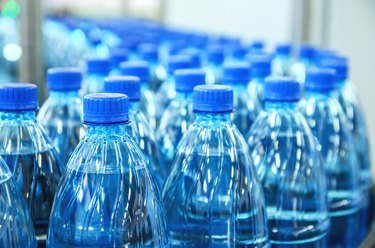
Container gardening is an alternative for people living in apartments or other areas with limited space. Raised containers are also convenient for those who find kneeling and stooping difficult. Filling large pots with soil can be expensive, and those big pots are heavy when filled with dirt. Partially filling the pots with plastic bottles addresses those concerns, while adding an extra kind of "green" to your garden.
Save on Soil Expense
Video of the Day
Many gardeners struggle with filling an entire flower pot with expensive potting soil. That may leave you wondering what to put in the bottom of the flower pot. By filling the bottom of your pot with old plastic soda bottles, you are able to use considerably less potting soil than you would otherwise.
Video of the Day
Depending on the plants you are growing, you can fill the large flowerpots half to two-thirds with capped soda bottles, water bottles or other containers of similar sizes. In addition, because you are using less soil, you lower the risks of spreading plant diseases found in unsterilized soil and you may need less plant fertilizer, since less will be lost to the soil itself.
Move Your Plants With Ease
Large flower planters filled with quality potting soil can be heavy and difficult to move around, especially if you are using terracotta or ceramic planters. Even setting the pots on saucers with casters may not allow some gardeners to move those dirt-filled pots, and you may find just rotating the container for even light exposure nearly impossible, depending on its size.
Using a plastic bottle for planting, or even polystyrene foam, can provide the filler you need, and there's another advantage in the light weight of the plastic materials, according to Oklahoma State University Extension. By eliminating half or more of the dirt, you cut the weight significantly, making the pots much easier to relocate when necessary.
You also have the added advantage of not sending those plastic water bottles or empty milk jugs to the landfill, according to Family Handyman. Just remember to cap them so they don't store water that will drown your plant.
Watering is Easier
As long as you remember to leave those caps on the bottles, partially filling the pots with soda bottles will provide the needed drainage arrangements. If you fill the area containing the bottles with water, you may also find that you need to water your container garden less often, since the plastic-filled section serves the same purpose as the reservoirs of specialty self-watering pots.
Push the end of your garden hose blow the soil level, into the lower section and fill it with water. Even in hot, dry climates, you may be able to water once a week, rather than every other day.
Ecological Contributions of Using Plastic
Using plastic bottles to fill your plant containers allows you to "go green" and help the environment in several different ways. Repurposing the bottles means that they don't enter a landfill, easing the concerns related to an overload of garbage that does not break down quickly.
By holding the water in the pot, the bottles also contribute to resource conservation, which is especially important during hot summer months or droughts. So planting plastic bottles really does help save the environment.